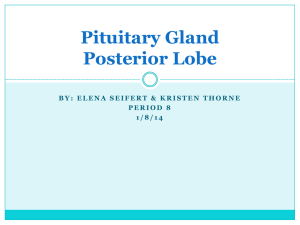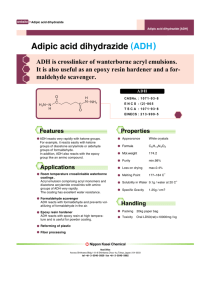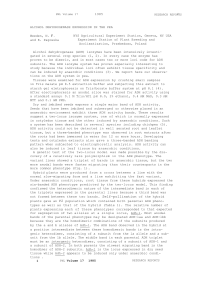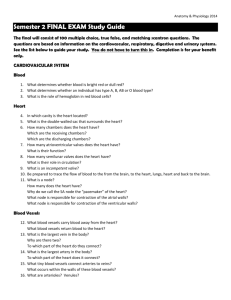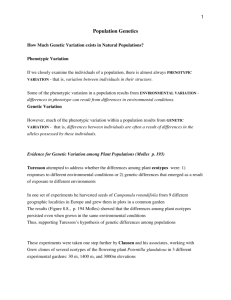99KB - NZQA
advertisement
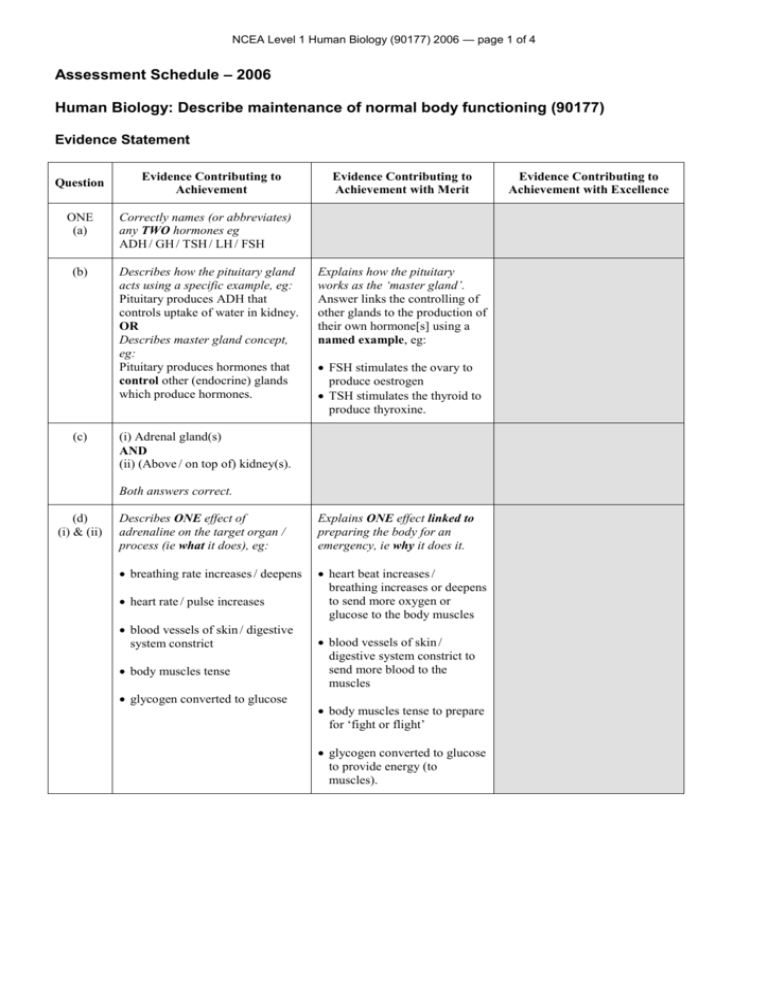
NCEA Level 1 Human Biology (90177) 2006 — page 1 of 4 Assessment Schedule – 2006 Human Biology: Describe maintenance of normal body functioning (90177) Evidence Statement Question Evidence Contributing to Achievement ONE (a) Correctly names (or abbreviates) any TWO hormones eg ADH / GH / TSH / LH / FSH (b) Describes how the pituitary gland acts using a specific example, eg: Pituitary produces ADH that controls uptake of water in kidney. OR Describes master gland concept, eg: Pituitary produces hormones that control other (endocrine) glands which produce hormones. (c) Evidence Contributing to Achievement with Merit Explains how the pituitary works as the ‘master gland’. Answer links the controlling of other glands to the production of their own hormone[s] using a named example, eg: FSH stimulates the ovary to produce oestrogen TSH stimulates the thyroid to produce thyroxine. (i) Adrenal gland(s) AND (ii) (Above / on top of) kidney(s). Both answers correct. (d) (i) & (ii) Describes ONE effect of adrenaline on the target organ / process (ie what it does), eg: Explains ONE effect linked to preparing the body for an emergency, ie why it does it. breathing rate increases / deepens heart beat increases / breathing increases or deepens to send more oxygen or glucose to the body muscles heart rate / pulse increases blood vessels of skin / digestive system constrict body muscles tense glycogen converted to glucose blood vessels of skin / digestive system constrict to send more blood to the muscles body muscles tense to prepare for ‘fight or flight’ glycogen converted to glucose to provide energy (to muscles). Evidence Contributing to Achievement with Excellence NCEA Level 1 Human Biology (90177) 2006 — page 2 of 4 Evidence Contributing to Achievement TWO (a) Evidence Contributing to Achievement with Merit Evidence Contributing to Achievement with Excellence Describes effect on the body of sweating in terms of the body becoming dehydrated. (b) Describes ONE of: blood brought closer to the skin surface capillaries dilate to lose body heat to cool down. Explains why flushed face happens, eg: Blood vessels / capillaries dilate to increase blood flow to face / skin. Linked to ONE of more heat lost / radiated to air increase blood cooling by air. OR Blood vessels / capillaries dilate to increase blood flow to face / skin which produces flushed effect. TWO (c) Describes ‘how’ in terms of Production of the hormone ADH Kidneys absorbing more water back into the body. Explains ‘how’ in terms of Stimulation / inhibition of ADH by the pituitary linked to The levels of water in the blood / body. Explained either through written answer or flow diagram. Both ideas needed. Discussion of how body restores its water balance in terms of Blood water levels detected by the hypothalamus which signals the pituitary to produce ADH ADH stimulates water uptake from kidney tubules back into body Restoration of normal water balance / higher levels of ADH causes hypothalamus to stop signalling production of ADH AND illustrated by an appropriate flow diagram that has arrows correctly linking the production of ADH to the level of water in the body, eg (see diagram): TWO (c) (Excellence) continued: flow diagram for example: Low level of water in blood / body detected by hypothalamus signals pituitary to release ADH More water reabsorbed into the body by the kidneys normal water balance in blood Normal water balance / high levels of ADH detected by hypothalamus ADH levels are reduced to maintain normal water balance NCEA Level 1 Human Biology (90177) 2006 — page 3 of 4 Evidence Contributing to Achievement THREE (a) Describes ONE short-term effect of alcohol, eg: heart works harder blood vessels widen (dilate) body loses more heat liver works harder person vomits kidneys produce more urine dehydrates body person suffers headache / nausea / dizziness / hangover slows reactions. 3(b) Description of long term effects of EITHER alcohol OR tobacco. Any two of: Alcohol, eg: brain damaged / brain cells killed heart [muscle] damaged liver cells damaged / destroyed stomach lining irritated / damaged pancreas irritated / damaged nervous system – may become addicted. Tobacco, eg: nervous system – addictive lungs – cilia destroyed; alveoli damaged; increase in lung diseases [cancer; emphysema; chronic bronchitis] heart and circulation – blood vessels constrict; heart rate increases; blood pressure increases; risk of CHD increases; increased risk of clotting; white cells anaesthetised; poor fitness. skin – circulation reduced; skin dries and wrinkles digestive system – ulcer risk increases; blood sugar increases; teeth stain cancers – increased risk of all types of cancer. Evidence Contributing to Achievement with Merit Explanation of how at least one process / function is affected. Alcohol, eg: Brain cells damaged causes loss of memory / impaired judgement / impaired learning. Heart damage impairs functioning and may lead to heart failure. Liver damage impairs functioning and may lead to cirrhosis / hepatitis / cancer. Stomach lining irritated, may lead to ulceration. Pancreas irritated, may lead to impaired flow of digestive enzymes and so digestive disorders. Possible link to diabetes. Addiction means that the person cannot stop drinking, so increasing the damage to all systems, leading to death. Tobacco, eg: Addiction means that the habit is very difficult to stop. Lungs cannot clean efficiently; alveoli damage means less surface for gas exchange. Heart is more prone to CHD leading to death. Damage to lungs and heart means that levels of fitness drop. Digestive system damage lead to digestive upsets / ulceration / greater difficulty in digesting food. Risk and death from all types of cancers, especially those of the respiratory system. Evidence Contributing to Achievement with Excellence Discussion of the impact on normal body function by the named process being affected. Alcohol, eg: Heart damage leads to stroke and / or heart failure which can lead to reduced quality of life / hospitalisation and / or death. Loss of memory / impaired judgement leads to reduced quality of life / physical damage etc. Impact of digestive disorders on quality of life / normal body function. Impact of addiction on quality of life / maintaining normal life functions. Tobacco, eg: lung damage and reduced gas exchange leads to reduced fitness, difficulty exercising, reduced quality of living. Heart damage affects ability to work / exercise etc. Ongoing health issues leading to immobility / reduced longevity / death. Impact of digestive disorders on quality of life / maintaining normal body function. Effect due to cancer on maintaining normal life functions, life expectancy, family, etc. NCEA Level 1 Human Biology (90177) 2006 — page 4 of 4 Judgement Statement Biology: Describe maintenance of normal body functioning (90177) Achievement FIVE questions answered correctly. Minimum 5 A Achievement with Merit SIX questions answered correctly, including at least THREE at Merit level. Minimum 3 M + 3 A Achievement Excellence SIX questions answered correctly, including at least TWO at Merit level and at least ONE at Excellence level. Minimum 1 E + 2 M + 3 A
